- About
- Topics
- Picks
- Audio
- Story
- In-Depth
- Opinion
- News
- Donate
-
Signup for our newsletterOur Editors' Best Picks.Send
Read, Debate: Engage.
| April 04, 2024 | |
|---|---|
| topic: | Ocean Pollution |
| tags: | #ocean pollution, #plastic, #plastic pollution, #recycling |
| located: | USA, India, China, United Kingdom |
| by: | Murat Suner |
80 per cent of plastics entering the oceans every year originate from land-based sources, rather than being discarded or lost from ships. A fraction of this marine litter includes fishing nets, gear and other materials inadvertently lost at sea.
We all witness our oceans and coastlines overwhelmed by plastic waste. Disturbing images often appear in the media, such as beached whales entangled in plastic bags or sea turtles caught in the plastic rings of soda cans.
About 82 per cent of all plastic waste entering the oceans is flushed through rivers. This includes litter, windblown debris, industrial and municipal waste. After reaching the sea, plastic decomposes at an extremely slow pace, breaking down into microplastics that pose significant harm to marine ecosystems.
Let's take a deeper dive into the journey of plastic from land to the ocean.
Globally, the practice of littering and directly disposing garbage into oceans, rivers and along beaches remains common. Rain or stormwater and wind can then carry the plastic waste into the sea or into drains that ultimately lead to the sea.
Additionally, careless and improper waste disposal along beaches, often due to inadequate waste management systems, results in plastic waste being directly or indirectly dumped into the oceans.
Even if you're a thousand miles from the sea, the plastic waste you dispose of might still end up in the ocean. Litter can get blown into rivers and streams, flowing out to sea. Trash from streets and trash cans can also be carried into waterways, sewers or directly into the ocean.
Many vacationers at coastal beaches tend to leave behind plastic water bottles and food packaging bags in the sand, which then directly make their way into the ocean.
Globally, nearly 400 tonnes of plastic waste is generated every year. Of that, only about 9 per cent gets recycled. This implies that most of the waste ends up being dumped, incinerated or discarded in the environment. Plastics that are thrown into bins are supposed to be collected and taken to landfill sites. However, lightweight plastics are at risk of being blown away by the wind during transportation, which leads to their escape into the environment.
Windblown plastic eventually clutters around drains, from where stormwater can sweep them into rivers, and eventually, they make their way to the ocean.
Even when disposed of in landfills, plastic can be carried off by the wind. It can also be washed out through storm drains from these sites and find its way into nearby rivers and ultimately, the sea.
Lightweight plastics, such as LDPE (low-density polyethylene) and packaging bags, are particularly prone to being carried away by the wind. Once in the water, these types of plastic tend to sink quickly because of their large surface area.
Many personal care and cosmetic products, including toothpaste, wet wipes, shower gels, face scrubs, and sanitary items, contain microbeads - extremely small plastic particles. These products, used daily, are flushed down toilets and enter our ecosystems. Municipal wastewater contains a variety of microplastics, from microbeads in toothpaste to synthetic fibers released during laundry.
Furthermore, many water treatment facilities are unable to filter out microplastics and fibers, which allows them to pass through treatment processes and directly enter rivers, eventually reaching the oceans.
Agricultural runoff, especially from areas where municipal sewage sludge is used as fertiliser on farmlands, also carries microplastics found upstream from these treatment plants and causes more pollution.
Finally, storm runoff water, carrying plastics from sewage, significantly impacts river systems, which then flow into the ocean. This process poses a substantial risk of microplastics entering marine environments, which in turn threatens aquatic life and ecosystems.
When the disposal of products containing plastics from industrial processes fails to meet proper standards, these processes become a source of plastic leakage into the environment. This leakage can occur during the production phase or while transporting the products.
For instance, a survey from 2019 revealed that thousands of tiny industrial plastic pellets are contaminating the UK's coastlines, with nearly three-quarters of its beaches affected annually by this pollution.
Once these plastics enter the ocean, they're carried by currents worldwide, leading to pollution that reaches even the most remote, uninhabited islands.
How does plastic get into the ocean? Through general littering, inadequate waste management and industrial activities. Littering is especially prevalent in regions lacking proper waste infrastructure. To give you some context: roughly two billion people globally lack access to solid waste collection services, according to the UN Environment Programme.
Ultimately, the responsibility lies with us. Whether through intentional littering or not, the plastic we dump has the potential to end up in the ocean. Tackling the issue of ocean plastics means addressing it at its source; this includes corporations taking significant steps to reduce the sale of single-use plastics.
By reducing the use of light, single-use plastics, we can decrease the amount thrown away. Governments should also improve waste management systems and promote plastic recycling to protect marine life from further harm.
Ultimately, solving the ocean plastics crisis starts at the source, and it's key to our battle against this environmental challenge.
By copying the embed code below, you agree to adhere to our republishing guidelines.

